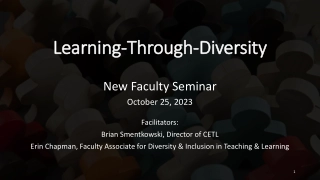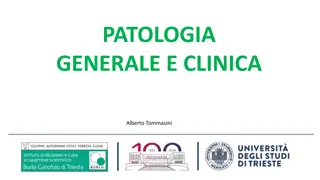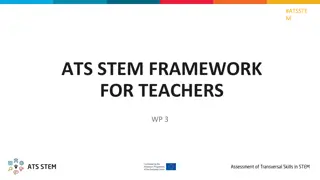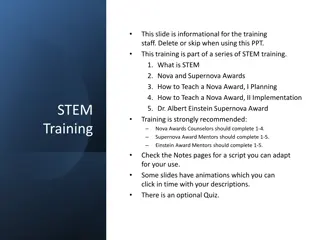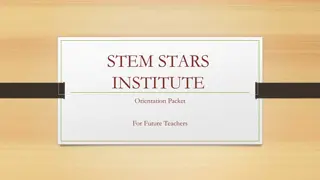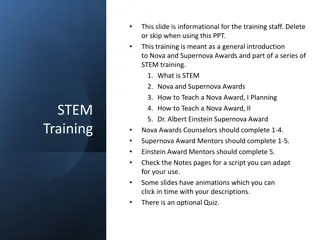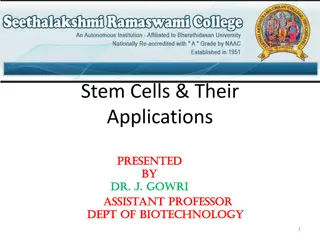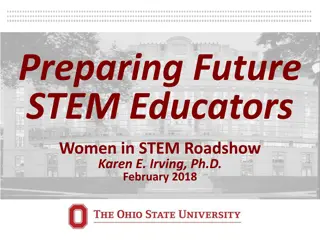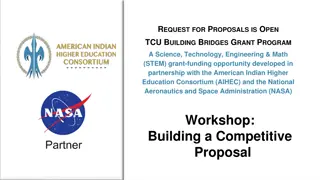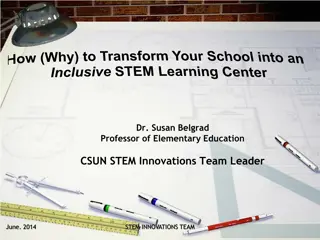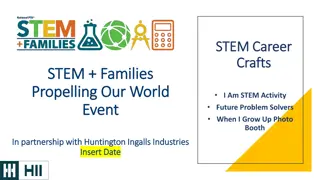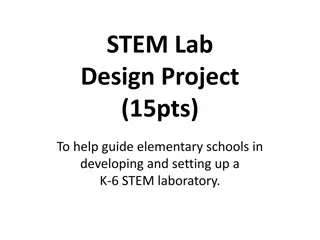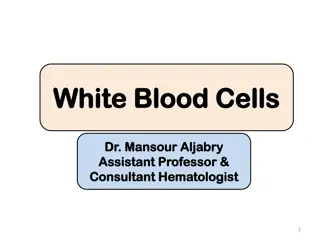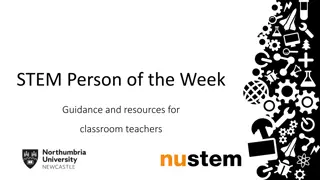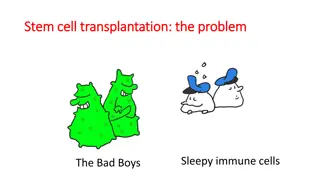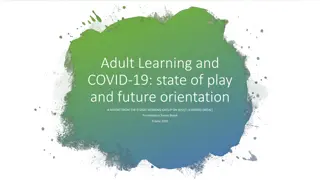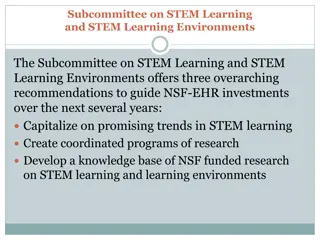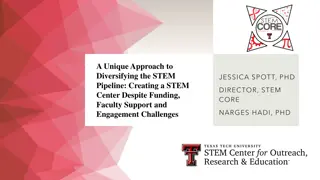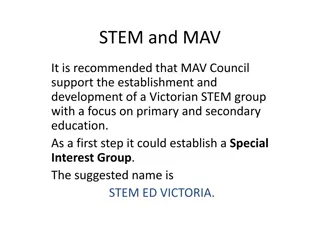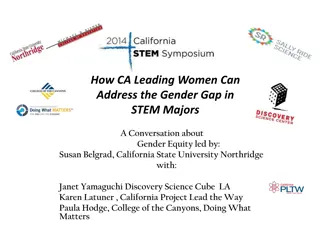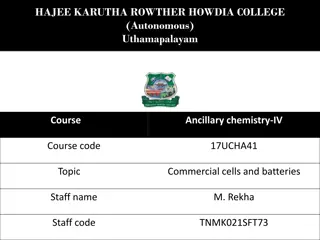Stem Cells
Role of stem cells in the body, different types of stem cells, and their potential in medicine. Developed by Carnegie Mellon students, Isabel Joyce and Cassandra Dodson.
0 views • 31 slides
Empowering Women in STEM: A South Deep Case Study
Dr. Adwoa Issaka presents a case study on empowering women in STEM at the Wits Women in Leadership event. The presentation highlights the underrepresentation of women in STEM fields in South Africa and emphasizes the importance of gender equality in education and skills development. The study from S
7 views • 15 slides
Enhancing STEM Education Through Diversity and Inclusion
Discover how the Center for the Integration of Research, Teaching, and Learning (CIRTL) aims to enhance excellence in STEM undergraduate education by developing a national faculty committed to implementing evidence-based teaching practices for diverse learners. Explore the concept of learning throug
0 views • 19 slides
Explore The Big Bang Challenge for STEM Engagement
The Big Bang Challenge provides students with exciting problems to solve in science, technology, engineering, and math (STEM). Through design thinking, participants develop important skills like communication and problem-solving while exploring various STEM areas. Choose from seven challenges, such
0 views • 94 slides
Hematopoiesis: Processes and Niches in the Human Body
Hematopoiesis, the process of daily blood cell production, involves maintaining the physiological balance of circulating blood cells. It includes the generation of billions of erythrocytes, platelets, and leukocytes to meet the body's needs. The location of hematopoiesis changes throughout human lif
4 views • 69 slides
Chronic Myeloid Leukemia
Chronic myeloid leukemia (CML), or chronic myelogenous leukemia, is a slow-growing form of cancer that affects the bone marrow and blood. Like acute myeloid leukemia, CML originates in the myeloid cells. When functioning properly, myeloid cells produce mature red blood cells, platelets and non-lymph
2 views • 7 slides
Understanding Electricity and Circuits: Components, Cells, Batteries, and Ratings
Explore the fundamentals of electricity and circuits, including circuit components, cells, batteries, types of cells, primary vs. secondary cells, dry vs. wet cells, and ratings. Learn about the relevance of this knowledge in engineering and certifications like NABCEP PV Associate. Discover the work
1 views • 18 slides
A Comprehensive Overview of ATS STEM Framework for Teachers
Explore the ATS STEM framework for teachers, focusing on key principles like problem-solving design, disciplinary knowledge, and integrated STEM practices. Discover how to incorporate transversal competencies and formative assessments into STEM education, supported by real-world contexts and appropr
0 views • 76 slides
Advancing Computer Science and STEM Education in Rural Lancaster County
PA Smart Grants, spearheaded by Governor Tom Wolf, are driving the advancement of computer science and STEM education in Pennsylvania. Manheim Central, along with other institutions, has secured grants to expand access to these crucial fields. Initiatives range from early childhood STEM programs to
2 views • 9 slides
Understanding Blood Cells and Transport Mechanisms
Your blood, consisting of red blood cells, white blood cells, platelets, and plasma, plays a crucial role in transporting substances like oxygen, nutrients, and waste products throughout your body. Red blood cells are specialized for oxygen transport due to their unique adaptations, while white bloo
2 views • 18 slides
STEM Training Series for Nova and Supernova Awards
This informational PowerPoint presentation is part of a STEM training series for Nova and Supernova Awards. Covering topics such as understanding STEM, Nova and Supernova Awards, mentoring requirements, research projects, and more, this training provides valuable insights for counselors and mentors.
2 views • 21 slides
Exploring the Importance and Integration of STEM Education
STEM education, encompassing science, technology, engineering, and mathematics, has gained significant importance in the early 2000s due to its crucial role in fostering innovation, addressing societal challenges, and enhancing economic competitiveness. The integration of these disciplines offers a
0 views • 19 slides
STEM STARS Institute - Empowering Future STEM Educators
STEM STARS Institute focuses on enhancing science and math education for preK-12 students in the Deep South through innovative teacher residency programs. Supported by a National Science Foundation grant, the initiative aims to provide certified instructors to students in Arkansas, Mississippi, and
3 views • 12 slides
Introduction to STEM Training for Nova and Supernova Awards
This presentation serves as a general introduction to Nova and Supernova Awards as part of a STEM training series for scouting staff. It covers topics such as understanding STEM, teaching Nova Awards, the Einstein Supernova Award, and incorporating STEM into scouting programs. The content includes i
3 views • 16 slides
Understanding Stem Cells and Their Potential Applications
Stem cells are undifferentiated cells with the unique ability to develop into various specialized cell types, making them valuable for medical applications. Dr. J. Gowri explores the classification, features, and properties of stem cells, shedding light on their self-renewal and potency. These cells
3 views • 19 slides
Understanding Stem Cells and Their Applications
Stem cells are unique cells that have the potential to develop into various types of cells in the body. They play a crucial role in renewing and repairing tissues, offering hope for treating various medical conditions. While adult stem cells can differentiate into limited cell types, embryonic stem
0 views • 9 slides
Empowering Future STEM Educators for a Brighter Tomorrow
Delve into the world of STEM education through the lens of Dr. Karen E. Irving's insightful roadshow in February 2018. Explore the challenges and opportunities in preparing the next generation of STEM professionals. Discover the importance of effective teaching in bridging the gap between STEM conte
0 views • 45 slides
Building Bridges Grant Program for STEM Education
TCU Building Bridges Grant Program offers funding opportunities for Tribal Colleges & Universities faculty-led teams to enhance STEM education, research, and curriculum. The program aims to increase student engagement in STEM activities, enrollment in STEM degree programs, and strengthen STEM capaci
0 views • 21 slides
Identifying Plant Cells Under Microscope
Observing well-defined cells with clear presence of cell walls would help conclude that the cells are plant cells, distinguishable from animal cells by the absence of cell walls. The detection of nuclei within each cell is a common characteristic observed in both plant and animal cells.
1 views • 274 slides
Transforming Your School into an Inclusive STEM Learning Center
Transforming a school into an inclusive STEM learning center involves creating a conducive environment for all students to excel in STEM disciplines. By implementing project-based learning, focusing on core STEM subjects, and addressing workforce development strategies, schools can empower diverse l
0 views • 29 slides
Exploring STEM Careers Through Hands-on Activities
Dive into the world of STEM careers with engaging activities designed to spark curiosity and inspire future problem solvers. Discover how hobbies and interests can lead to exciting opportunities in the STEM field, while building confidence and a sense of belonging in the STEM community. Join us for
0 views • 23 slides
Comprehensive Guide to Setting Up a K-6 STEM Laboratory
In this STEM lab design project, elementary schools are provided with a comprehensive booklet to help them establish a K-6 STEM laboratory. The booklet comprises five parts - Introduction, Description of the Space, Tools & Materials, Safety, and Resources. It covers the essence of STEM education, th
0 views • 14 slides
Understanding Hematopoiesis and White Blood Cells in Blood Formation Process
The process of hematopoiesis involves the lifelong production, multiplication, and specialization of different blood cells in the bone marrow, starting with the stem cells. This process includes the differentiation and proliferation of various progenitor cells, regulated by hematopoietic growth fact
0 views • 27 slides
Transforming STEM Education in Scotland: Key Findings and Recommendations
This document presents key findings from a survey on professional learning in STEM conducted in June 2017 for Scotland's learners, with insights from educators. The survey received a strong response from various practitioners, highlighting the importance of tailored STEM CLPL programs to achieve Sco
0 views • 11 slides
Promoting STEM Diversity in Education with STEM Person of the Week
STEM Person of the Week is a teacher-led intervention program aimed at reducing stereotypes around science and scientists. Through posters, postcards, and presentations, students are introduced to diverse STEM role models and encouraged to focus on positive attributes. The initiative helps break dow
0 views • 9 slides
Comparison of Eukaryotic and Prokaryotic Cells in Cell Biology
Cells are the fundamental units of life, but viruses are an exception as they lack cells. Eukaryotic cells have a defined nucleus with a nuclear membrane housing chromosomes, while prokaryotic cells lack a membrane-bound nucleus and other organelles. Eukaryotic cells are larger, containing membrane-
0 views • 9 slides
Cell Division Mechanisms in Prokaryotic and Eukaryotic Cells
Prokaryotic cells divide through binary fission, while eukaryotic cells undergo mitosis with nuclear division and cytokinesis. Prokaryotic cells lack a nucleus and divide by replicating DNA and forming two identical daughter cells. Eukaryotic chromosomes, associated with histone proteins, undergo co
0 views • 56 slides
Understanding Stem Cell Transplantation: Removing Sleepy Immune Cells and Fighting "The Bad Boys
Stem cell transplantation involves addressing the issue of immune cells failing to recognize and eliminate tumor cells, known as "The Bad Boys." By removing the dormant immune cells and replacing them with new ones from a compatible donor, the therapy aims to empower the immune system to target and
0 views • 8 slides
Overview of Small Intestine Histology and Function
The small intestine is a key organ in the digestive system responsible for the digestion and absorption of nutrients. It is divided into the duodenum, jejunum, and ileum, each with specific functions and structures like plicae circulares, villi, microvilli, and crypts of Lieberkühn. The intestinal
0 views • 14 slides
Adult Learning and COVID-19: Impacts and Future Perspectives
This report discusses the impacts of the COVID-19 crisis on adult learning, explores the role of adult learning in crises, and provides insights to support discussions at national and European levels. It covers effects of COVID-19, coping mechanisms in the adult learning sector, and early scenarios
0 views • 11 slides
Understanding Stem Cells and Cell Potency in Animal Cells
Stem cells play a crucial role in animal cells, offering the potential to differentiate into various cell types. Totipotent stem cells are the most versatile, capable of developing into any cell type in the embryo, including extra-embryonic cells. Pluripotent stem cells can give rise to all body cel
0 views • 22 slides
Recommendations for Advancing STEM Education
The Subcommittee on STEM Learning and STEM Learning Environments provided three key recommendations for guiding NSF-EHR investments in the coming years. These recommendations include capitalizing on emerging trends in STEM learning, developing coordinated research programs, and creating a knowledge
0 views • 7 slides
The Impact of STEM Ambassadors in Education
STEM Ambassadors, like Mark Gallaway, play a crucial role in inspiring and educating students, teachers, and corporations in the fields of science, technology, engineering, and mathematics. They help improve presentation skills, boost confidence, and enhance understanding of STEM subjects. Through t
0 views • 9 slides
Creating a Diverse STEM Center: Overcoming Challenges and Promoting Inclusion
STEM CORE at Texas Tech University aims to enhance STEM education, outreach, and research while promoting diversity and inclusion. Despite funding and faculty support challenges, they focus on providing services to faculty, K-12 outreach, and fostering an inclusive STEM community through strategic i
0 views • 8 slides
Empowering STEM Education in Victoria: A Call to Action for MAV Council
Encouraging MAV Council to support the creation of a Victorian STEM group focused on primary and secondary education. The proposal includes establishing a Special Interest Group named STEM ED VICTORIA. The document highlights the essential skills, ways of thinking, and knowledge valued in STEM field
0 views • 14 slides
Addressing the Gender Gap in STEM Majors: Insights from Leading Women
Successful women leaders in science and engineering are collaborating with informal science organization leaders to address the gender gap in STEM majors. They aim to encourage girls to enroll and persist in STEM K-15 curricula, fostering a sense of belonging in technology and engineering discipline
0 views • 15 slides
Insights into Successful K-12 STEM Education Initiatives
Delve into a comprehensive report on successful K-12 STEM education, focusing on identifying effective approaches in Science, Technology, Engineering, and Mathematics. The report outlines criteria for determining success in STEM education, emphasizing goals to expand student participation in STEM ca
0 views • 13 slides
Understanding Commercial Cells and Batteries in Chemistry
Commercial cells and batteries are essential sources of electrochemical electricity. There are two main types: primary cells, which are one-time use and irreversible, and secondary cells, which are rechargeable and reversible. Examples include dry cells and lead storage cells. The components and rea
1 views • 12 slides
Understanding Fuel Cells: Definition, Working, and Applications
Fuel cells are electrochemical cells that generate electricity through reactions between fuel and an oxidizing agent like oxygen. They offer high efficiency compared to traditional power plants. The working of fuel cells involves hydrogen and oxygen reacting to produce electricity. NASA has utilized
0 views • 20 slides
SCWI/IJECT Collaboration for Adult Education: Enhancing Transitions to Postsecondary
The SCWI/IJECT initiative aims to improve transitions for adult students into college and apprenticeship programs through collaborative activities and programs. The 2022-25 requirements focus on expanding awareness of adult Dual Credits and supporting adult students in Adult Day Schools and Continui
0 views • 33 slides


